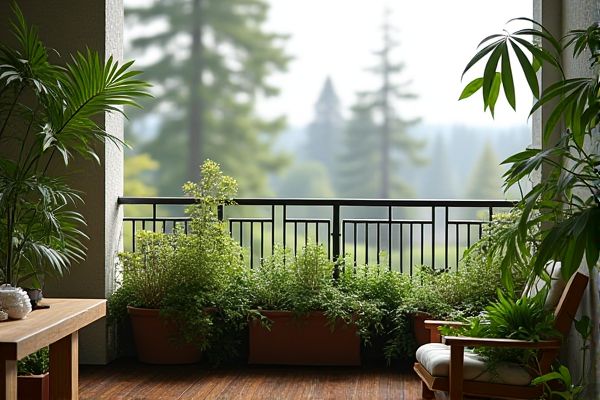
Wall planters maximize vertical space by securely attaching to walls, making them ideal for small terraces with limited floor area. Railing planters, designed to hang over balcony railings, provide easy access and a charming decorative touch to your outdoor space; explore the rest of this article to discover which option suits your terrace best.
Table of Comparison
| Feature | Wall Planter | Railing Planter |
|---|---|---|
| Mounting Location | Fixed directly on wall surfaces | Attached to balcony or terrace railings |
| Space Utilization | Maximizes vertical wall space | Optimizes railing edges, saves floor space |
| Weight Capacity | Supports medium to heavy pots with secure anchoring | Best for lightweight to medium planters |
| Installation Ease | Requires drilling and wall anchors | Simple clamping or hooking, no wall damage |
| Plant Options | Suitable for decorative plants, succulents, herbs | Ideal for trailing plants and herbs |
| Drainage | May need drainage holes; consider wall protection | Typically includes built-in drainage, less wall impact |
| Maintenance | Accessible but may require ladder for tall walls | Easy reach, convenient watering and pruning |
| Durability | Depends on wall type and mounting hardware | Depends on railing material and planter clamps |
| Use Case | Ideal for enhancing terrace walls and vertical gardens | Perfect for decorating balcony edges and small terraces |
Introduction to Terrace Planters: Wall vs Railing
Terrace planters offer versatile options for enhancing outdoor spaces, with wall planters providing a space-saving solution by attaching directly to vertical surfaces, ideal for small terraces. Railing planters, designed to hang securely on balcony or terrace railings, maximize limited space while offering easy access for watering and maintenance. Choosing between your wall or railing planter depends on your terrace layout, weight capacity, and desired aesthetic impact.
Key Differences Between Wall and Railing Planters
Wall planters mount directly onto vertical surfaces, offering sturdy support and a sleek, space-saving design perfect for terraces with limited floor area. Railing planters attach securely to balcony or terrace railings, providing adjustable placement and enabling you to maximize planting space without compromising safety. Your choice depends on the terrace structure and the type of plants you want to showcase, considering factors like weight capacity and sunlight exposure.
Space Efficiency and Placement Considerations
Wall planters maximize vertical space by attaching directly to terrace walls, making them ideal for small areas and freeing up floor space for other uses. Railing planters secure onto balcony or terrace railings, offering flexible placement but requiring adequate railing width and strength to support the weight. Your choice depends on available terrace structures and how much space you want to dedicate to gardening versus movement.
Aesthetic Appeal: Enhancing Terrace Design
Wall planters elevate terrace aesthetics by providing a vertical garden that maximizes space while adding vibrant, living art directly onto the walls. Railing planters offer a charming, cascading effect, softening the terrace edges with lush greenery and colorful flowers that complement outdoor furniture. Both options enhance terrace design by integrating nature seamlessly, but wall planters create a bold, structured statement, whereas railing planters contribute to a more relaxed, flowing ambiance.
Installation Process: Simplicity vs Complexity
Wall planters offer a straightforward installation process, typically requiring only drilling and anchoring directly onto the terrace wall, making them ideal for those seeking simplicity. Railing planters involve more complex installation, often necessitating clamps or brackets that securely attach to various railing sizes, demanding precise measurements and adjustments. Choosing a wall planter can save you time and effort, while railing planters provide flexibility but require a more detailed setup.
Plant Variety and Growth Support
Wall planters support a wide range of climbing and trailing plants such as ivy, ferns, and succulents, allowing vertical growth that maximizes limited terrace space. Railing planters are better suited for flowering plants, herbs, and small shrubs that require sturdy support and easy access to sunlight. Your choice between wall and railing planters should consider the specific plant variety's growth habits and structural needs for optimal health and aesthetics.
Accessibility and Maintenance Comparison
Wall planters offer easy access for watering and pruning due to their fixed height and proximity to the wall, reducing the need for bending or reaching. Railing planters may require leaning over or reaching around the terrace railing, which can be less convenient and potentially less safe for maintenance tasks. Your choice depends on whether you prioritize comfort and ease of upkeep or maximizing terrace space.
Durability and Weather Resistance
Wall planters and railing planters both offer unique advantages in durability and weather resistance, but wall planters typically provide greater stability due to their secure attachment to walls, reducing exposure to wind damage. Railing planters often face more direct weather elements, which can lead to faster wear and require materials like powder-coated metal or UV-resistant plastics for enhanced longevity. Choosing your planter based on these factors ensures your terrace greenery thrives despite varying weather conditions.
Cost Analysis: Budgeting Your Terrace Garden
Wall planters generally offer a more cost-effective solution for terrace gardens, as their installation requires fewer materials and less structural modification compared to railing planters. Railing planters often involve higher expenses due to the need for sturdy mounting brackets and weather-resistant materials to ensure safety and durability in outdoor conditions. Your budgeting should account for these differences, prioritizing wall planters if minimizing initial investment is the goal while considering the aesthetic and spatial impact of each option.
Choosing the Right Planter for Your Terrace Needs
Wall planters maximize vertical space on terraces, ideal for small areas where floor space is limited, offering easy access for watering and maintenance. Railing planters provide stability by attaching directly to balcony or terrace railings, allowing you to create a green barrier without sacrificing ground area. Your choice depends on the terrace's structural features and the nature of the plants you wish to grow for optimal growth and aesthetic appeal.
 homyna.com
homyna.com